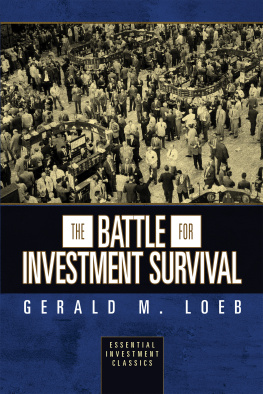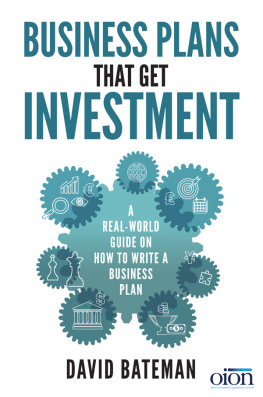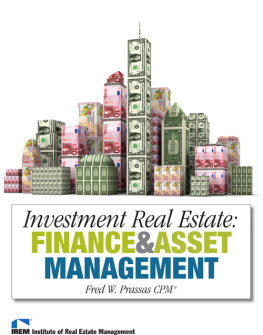
The Battle for Investment Survival
ESSENTIAL INVESTMENT CLASSICS
The Battle for Investment Survival
by Gerald M. Loeb
Reminiscences of a Stock Operator
by Edwin Lefvre
The Battle for Investment Survival
Gerald M. Loeb
Published 2020 by Gildan Media LLC
aka G&D Media
www.GandDmedia.com
THE BATTLE FOR INVESTMENT SURVIVAL. Copyright 2020 G&D Media. All rights reserved.
No part of this book may be used, reproduced or transmitted in any manner whatsoever, by any means (electronic, photocopying, recording, or otherwise), without the prior written permission of the author, except in the case of brief quotations embodied in critical articles and reviews. No liability is assumed with respect to the use of the information contained within. Although every precaution has been taken, the author and publisher assume no liability for errors or omissions. Neither is any liability assumed for damages resulting from the use of the information contained herein.
Front cover design by David Rheinhardt of Pyrographx
Interior design by Meghan Day Healey of Story Horse, LLC
Library of Congress Cataloging-in-Publication Data is available upon request
eISBN: 978-1-7225-2367-1
10987654321
Contents
Foreword
R emember the old saw: Those who can, do. Those who cant, teach or write success stories.
Without for a moment implying that all teachers and authors lack the ability to do the things they teach and write about, the publishers undertook to prove the old adage false by persuading a successful speculator to revise his book in which he tells how he does it.
The author is a seasoned stock broker and the material in this book is distilled from his 35 years of experience in Wall Street, plus knowledge gained from study of the ups-and-downs of thousands of brokerage accounts. But, he is not an ivory-tower theorist. He has tested his accumulated knowledge in the hot forge of the market place with millions of dollars of cold cash. His findings are now available to the readers of this book.
Until the stock market debacle of 1929, security-holders were inclined to accord their invested capitalthe life-blood of their economic existenceless attention than they gave to their automobile or teeth. Once a good investment, always a good investment seemed to be their attitude. But Mr. Loeb sets forth the inescapable investment doctrine that eternal vigilance is the price of success and bluntly states that an ideal investment is totally non-existent.
In substance, this book is hard-boiled realistic, at times unorthodox. It promises no short cuts to wealth; neither does it take the sour grapes attitude that Wall Street is a snare and delusion. Rather it is a succinct, straight-forward, uncompromising revelation of stock market technique and philosophy by one who has been successful enough to make his views worth recording.
Acknowledgement
S ome of the articles contained in the following chapters originally appeared in Barrons, The Commercial and Financial Chronicle, Investor Magazine, Trusts and Estates and American magazine.
The chapter I Dont SellPeople Buy from Me, is from How I Made the Sale That Did the Most for Me, compiled and edited by J. M. Hickerson, Prentice-Hall, Inc., 1951.
Introduction
T he publication of this new and greatly enlarged edition of The Battle for Investment Survival is due to two factorsthe steady demand for the other edition which is now out of print and the generally flattering comment made by various readers of that edition. The contents of the earlier book are included here, practically without change, but this edition contains considerable additional material.
A reader of one of my earlier discussions askedHave, you ever tried out the ideas outlined in your book? My reply was to the effect that the ideas were tried out first, and the book written afterward.
Any earner who earns more than he can spend is automatically an investor. It doesnt matter in the slightest whether he wants to be or not, or even whether he realizes that he is investing.
Storing present purchasing power for use in the future is investing, no matter in what form its put away. Some popular and common forms include money itself, government bonds, savings bank deposits, real estate, commodities, securities of all types, diamonds and where and when its legal, gold.
The real objective of investment is fundamentally to store excess current purchasing power for future use. A man lays brick all day and earns $16. Perhaps in ten days he saves $16 and invests it for the future. Some day he may want someone else to build a house for him, and he would like to hire a bricklayer at that time to do a days work for the $16 he saved. That at least is the ideal situation.
In real life, it works a little differently. The value of money fluctuates. In later years, it surely will not cost exactly $16 to hire a bricklayer for a day. It may cost only $12. Or then again, more likely, it will cost $20. Thus, just keeping the $16 wont always do.
The average individual will pay storage and insurance for putting away things he wants to keep for the future. But when it comes to putting away savings he not only does not expect to pay, but also he wants others to pay him either interest or dividends for the use of his savings. If he feels as well that there are risks involved of not getting it all back, then he wants to be paid a profit besides, either in the form of a higher rate of income or a potential capital gain. Altogether, of course, he expects too much and aims at too little.
Next page













